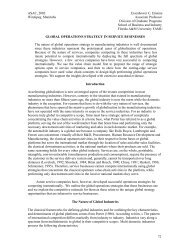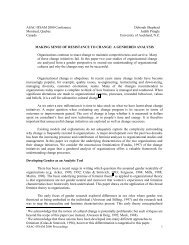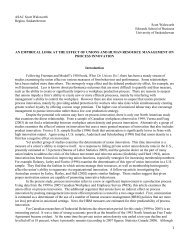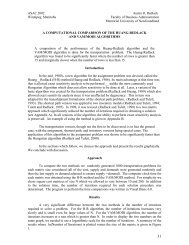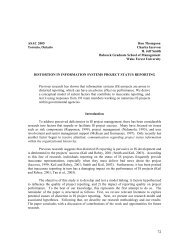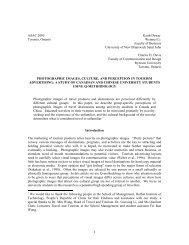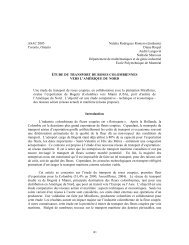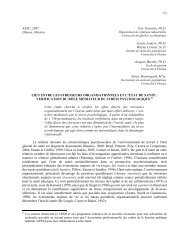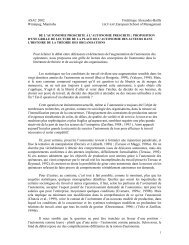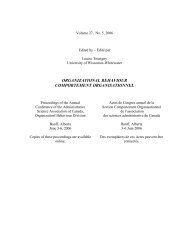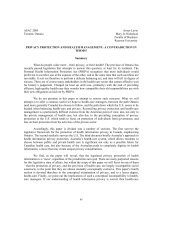Organizational Behaviour Comportement Organisationnel
Organizational Behaviour Comportement Organisationnel
Organizational Behaviour Comportement Organisationnel
Create successful ePaper yourself
Turn your PDF publications into a flip-book with our unique Google optimized e-Paper software.
TaskThis study required the use of two group discussion tasks that could trigger significantlydifferent perceptions regarding the relative expertise or status of males and females. As mentionedabove, previous research has successfully employed gendered tasks, via stereotypical content, as ameans to generate differences in perceived expertise among men and women in mixed-gendercontexts (e.g., Carr, Thomas & Mednick, 1985; Vancouver & Ilgen, 1989; Lippa & Beauvais, 1983).Our study employed two different managerial-related tasks used by Karakowsky & Siegel (1999)which were confirmed by the authors to be male-stereotyped and female-stereotyped. Karakowsky &Siegel (1999) confirmed that the MT triggered higher levels of perceived expertise for malescompared to females. On the other hand, the FT triggered higher levels of perceived expertise forfemales compared to males. Consequently, these cases, by definition, serve as manipulations ofperceived status or expertise.ProcedureWithin a time period of thirty minutes, all groups were instructed to reach a consensusregarding the development of a negotiation strategy for the protagonists in two assigned cases asdiscussed below. The research assistant distributed the first case, allowed the group several minutesto read it, and then activated the video-recording equipment. The assistant then left the room for theduration of the group discussion. After the allotted time, the assistant returned, shut off thecamcorder and distributed the first set of questionnaires. The research assistant followed identicalprocedures for the second group discussion task, after which time the participants’ involvement inthe study ended. To control for possible confounding effects, the order of the two types of tasks werecounterbalanced, as was the use of a male or female research assistant in facilitating the datacollection.Dependent Variable MeasuresInterruption Behavior. Numerous researchers have acknowledged three fundamentallydifferent types of interruptions: supportive or rapport-oriented interruptions (i.e., agreements, positiverequests for information); neutral (i.e., elaborations on the topic of the interrupted speaker withoutevaluative content, requests for clarification); intrusive or negative (i.e., introducing topic changes,raising objections) (Goldberg,1990; Smith-Lovin and Brody, 1989). This study focuses on intrusiveinterruptions since they have been viewed as the clearest indicator of power displays (Anderson &Leaper, 1998; Goldberg, 1990). This type of interruption best reflects a form of dominance,particularly given its intent to usurp the speaker’s turn at discussion.With regard to measurement, the videotaped group discussions were observed by three maleand three female judges (graduate psychology students). Both men and women were used as judgesto control for possible gender differences in observations given previous suggestions that male andfemale observers can differentially rate interruption behavior (Crown & Cummins, 1998). Thejudges received a training session on the observation and scoring of group member interruptions,using the definition of interruptions described above. Specifically, all judge observers were trainedto observe and account for interruptions that could be classified as intrusive or negative interruptions(as opposed to supportive or neutral interruptions). This included successful attempts to preventanother speaker from completing a conversational turn and could include such characteristics as:expressing disagreement with the speaker; raising an objection to the speaker’s idea; or introducing acomplete change in topic (completely disregarding the initial speaker’s utterance) (Anderson &Leaper, 1998; Smith-Lovin & Brody, 1989).Judges were assigned to view 24 videotaped group discussions. All 72 group discussionswere randomly assigned - the random assignment was restricted in the sense that each judge did not6



